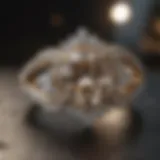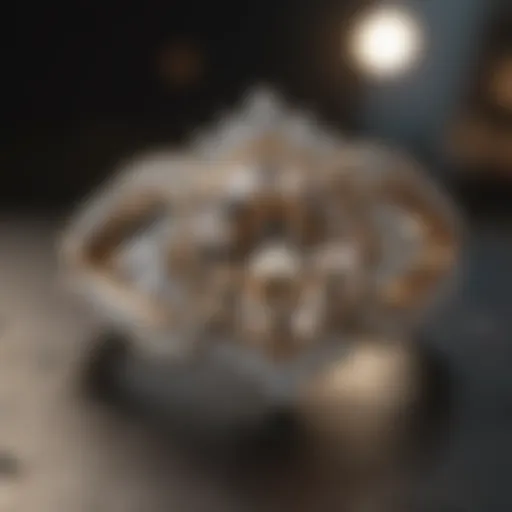Maximizing Sparkle: Understanding Diamond Cuts
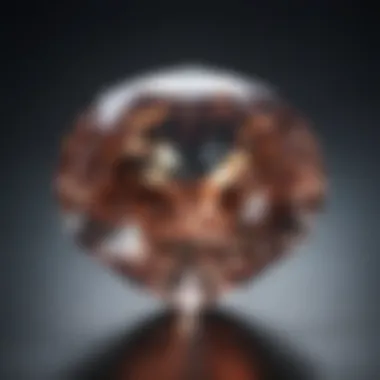

Intro
The world of gemstones is both captivating and complex. Each stone tells a unique story, shaped by both natural processes and human intervention. In particular, diamonds stand out not just for their beauty but also for the intricate ways in which their cuts can maximize sparkle and brilliance. This article will explore the science behind diamond cuts, the critical role they play in light interaction, and how to select the perfect diamond cut for any occasion. We aim to arm both gem enthusiasts and jewelry professionals with knowledge that will enhance their appreciation of these remarkable stones.
Overview of Gemstones and Minerals
Gemstones and minerals have been prized for their beauty and rarity across cultures and eras. Their significance extends beyond mere aesthetics.
History of Gemstone and Mineral Use
Historically, gemstones have served various roles—from symbols of wealth to tools of spiritual significance. Ancient civilizations utilized gemstones for decoration, trade, and even protection from negative energies. For example, in ancient Egypt, turquoise and lapis lazuli were revered not only for their rarity but also for their association with deities.
Significance in Culture and Society
Various cultures attribute special meanings to gemstones. For instance, sapphires are often associated with wisdom and nobility, while rubies are deemed symbols of passion and energy. Understanding these cultural contexts can enhance one’s appreciation of gemstones.
Gemstone Formation and Properties
Formation Process of Gemstones
Gemstones form through distinct geological processes. Most well-known are igneous, metamorphic, and sedimentary formations. Diamonds, specifically, form deep within the Earth’s mantle under extreme pressure and temperature, evolving over millions of years.
Properties that Define Gemstones
The primary properties that characterize gemstones include hardness, refractive index, and specific gravity. Diamonds, for example, rate highest on the Mohs hardness scale, making them incredibly durable, yet their fascinating optical qualities stem from their unique crystalline structure.
Classification based on Color, Hardness, and Luster
Gemstones are classified based on their color, hardness, and lustre. While diamonds are usually colorless, they can also present in shades like blue or yellow due to impurities. Understanding these classifications aids in evaluating their beauty and value.
Types of Gemstones
Precious vs. Semi-Precious Gemstones
Gemstones are generally categorized into precious and semi-precious. Traditional precious stones include diamonds, rubies, sapphires, and emeralds. The rest, such as amethysts and garnets, fall under semi-precious stones. The delineation is largely historical and can be subjective based on contemporary perceptions of value.
Common Gemstone Varieties
Some common varieties include the aforementioned diamonds, sapphires, and emeralds. Each variety exhibits unique properties and cultural meanings, further enriching their narrative.
Exotic and Rare Gemstones
Exotic gemstones like tanzanite and alexandrite capture collector interest with their rarity. These stones not only fascinate enthusiasts but also often command high prices due to their uniqueness.
Identifying and Evaluating Gemstones
Factors Affecting Gemstone Value
Value is determined by several factors, including rarity, size, color, and clarity. Diamonds, for example, are evaluated based on the Four Cs: Carat, Cut, Color, and Clarity.
Techniques for Gemstone Identification
Identifying gemstones requires both skill and the right tools. Techniques include observing color, examining inclusions under magnification, and employing specific testing methods to determine hardness and refractive index.
Assessing Gemstone Quality
Quality assessment hinges on the combination of the aforementioned factors. A carefully cut diamond may shine more than a larger, raw stone. Thus, understanding the cut's impact on brilliance is essential.
Caring for Gemstones
Cleaning and Storing Gemstones Properly
Proper care is crucial to maintain the beauty of gemstones. Cleaning often involves gentle soap and water, avoiding harsh chemicals. Safe storage should protect against scratches and accidental damage.
Avoiding Common Mistakes in Gemstone Care
Many owners overlook the importance of avoiding exposure to heat or harsh chemicals. Regular inspections can help spot any signs of wear before they lead to greater damage.
Preservation Tips for Specific Gem Types
Different gemstones may require specific preservation techniques. For example, pearls need to be kept away from cosmetics and excessive moisture. Knowledge of these needs can prolong the lifespan and beauty of your gems.
"Understanding the intricacies of gemstone properties and care can significantly enhance the appreciation and value of your collection."
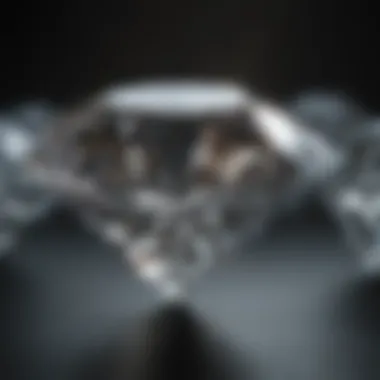

As we move to the next sections, the focus will shift specifically toward diamond cuts and how these unique shapes affect a diamond's ability to reflect light and create sparkle, providing insights that will be valuable for both consumers and industry professionals.
Prelude to Diamond Sparkle
When it comes to diamonds, the notion of sparkle is often the first aspect that catches the eye. This initial impression plays a crucial role in a buyer’s decision-making process. Understanding sparkle means more than just appreciating beauty; it encompasses the science, geometry, and artistry behind diamond cuts. The importance of this topic lies in its ability to empower enthusiasts with knowledge, elevating their appreciation of such gems.
Defining Sparkle
Sparkle in diamonds is defined by two main elements: brilliance and fire. Brilliance refers to the white light that reflects off the diamond's surface, while fire describes the colored light that is dispersed within the stone. Together, these two properties create the unique visual appeal that captures attention. The technological aspects involve how light enters, interacts, and exits the diamond, influenced heavily by its cut, proportions, and polish. When one observes a diamond, its sparkle can often evoke emotions and signify value, giving it lasting allure.
Importance of Cut in Diamonds
The cut of a diamond is arguably the most significant factor affecting the sparkle. Unlike characteristics such as color, clarity, or carat weight, the cut is what transforms a rough stone into a dazzling masterpiece. A well-executed cut enhances light performance, allowing brilliance and fire to reveal themselves. Each cut, from the iconic Round Cut to the sleek Emerald Cut, possesses distinct attributes that directly influence the aesthetic outcome.
The relationship between cut and sparkle can be summarized in several key points:
- Light Performance: A well-cut diamond allows maximum light performance, resulting in optimal sparkle.
- Proportions: Precise proportions can enhance a diamond’s beauty, while improper proportions can lead to a dull appearance.
- Personal Preference: Different cuts cater to varied tastes, impacting how individuals perceive sparkle.
Understanding the role of cut provides a foundation for not just acquisition but also appreciation of diamonds.
"The cut is the only factor that an expert can influence directly when crafting a diamond, making its importance paramount in the quest for brilliance."
Equipped with insights into sparkle and cut, readers can approach diamond selection with greater confidence and knowledge. This section lays the groundwork for a deeper exploration of diamond cuts in subsequent sections.
Understanding Diamond Cuts
Understanding the intricacies of diamond cuts is essential for anyone interested in diamond selection and evaluation. The cut of a diamond directly affects its sparkle, brilliance, and overall aesthetic appeal. In this section, we will explore the various techniques and types of cuts, highlighting their significance and the factors that contribute to maximizing the diamond's visual impact.
Overview of Diamond Cutting Techniques
Diamonds are shaped and polished using various techniques that influence their final appearance. The skills involved in diamond cutting require immense precision and artistry. Here are common techniques used in cutting diamonds:
- Brilliant Cut: This technique is popular for its ability to maximize brilliance through optimal light reflection and refraction. The round shape allows for an ideal arrangement of facets, enhancing sparkle.
- Step Cut: Used mainly in emerald and Asscher cuts, this technique creates a series of parallel facets that reflect light in a distinctive way. It emphasizes clarity rather than the fiery sparkle.
- Mixed Cut: Combines elements of both brilliant and step cuts to create a versatile diamond that meets varying aesthetic preferences.
Each cutter adapts these techniques based on the rough diamond's characteristics, such as its shape and inclusions. The craftsmanship involved plays a significant role in determining the diamond's final value.
Types of Cuts and Their Characteristics
Round Cut
The Round Cut is perhaps the most recognized and favored diamond shape. Its circular form plays a vital role in maximizing brilliance. The key characteristic of this cut is its impressive ability to reflect light in various directions.
- Unique Feature: The proportion of facets in a Round Cut, typically 58, allows for exceptional light performance.
- Advantages: This cut is highly sought after for engagement rings, due to its classic allure and timelessness. However, the downside is that they might come at a higher price compared to other shapes due to the weight loss during cutting.
Princess Cut
The Princess Cut has gained popularity for its contemporary style and sharp lines. It offers a modern aesthetic while still providing remarkable sparkle.
- Key Characteristic: This cut combines the brilliance of the Round Cut with the outline of a square, making it attractive for a variety of jewelry designs.
- Unique Feature: The cut often retains a significant portion of the rough diamond, leading to a favorable cost per carat. One disadvantage could be its tendency to show white inclusions more prominently than round cuts.
Emerald Cut
Emerald Cut is uniquely different from the first two cuts due to its elongated shape and subtle elegance. It is known for its step cut design, which emphasizes clarity.
- Key Characteristic: The wide, flat facets of an Emerald Cut create a mirror-like effect that showcases the diamond’s internal qualities.
- Unique Feature: It’s an excellent choice for larger diamonds as the cut can enhance their size appearance. However, color is more noticeable in this cut, necessitating higher clarity grades.
Oval Cut
The Oval Cut combines traditional elegance with a modern twist. Its elongated shape creates the illusion of a larger diamond, attracting many buyers.
- Key Characteristic: It typically exhibits a similar brilliance to the Round Cut.
- Unique Feature: The cut can accommodate different carat weights while maintaining a desirable visual appeal. A possible disadvantage is that some may find its shape less classic than the Round Cut.
Asscher Cut
The Asscher Cut, with its art deco inspiration, is recognizable for its square shape and stepped facets.
- Key Characteristic: This cut is known for its vintage appeal and geometric pattern.
- Unique Feature: The Asscher Cut excels in transparency and tends to magnify the diamond’s clarity. However, its niche appeal may limit its widespread popularity in compared to more mainstream cuts.
Understanding these cuts and their characteristics is pivotal for anyone looking to maximize sparkle and overall diamond quality. Be it for personal jewelry or for professional selection, each cut tells a unique story that can influence choice and preference.
The Role of Light in Sparkle
Light plays a pivotal role in the sparkle of diamonds. It is not just about how a diamond is cut but also how light interacts with its facets. This interaction ultimately determines the visual appeal and brilliance of the stone. A well-cut diamond will reflect and refract light optimally, producing a mesmerizing sparkle that can captivate anyone. Understanding the mechanics of light in relation to diamonds is essential for anyone who appreciates these gemstones.
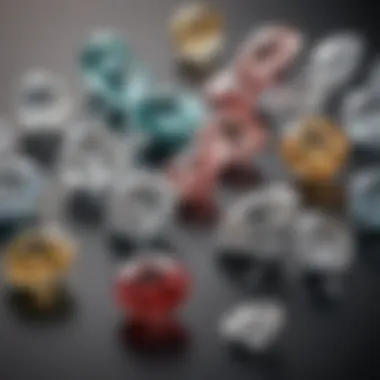

Refraction and Reflection
Refraction and reflection are the core principles that enable diamonds to exhibit their sparkling nature. When light strikes the surface of a diamond, some of it reflects off the surface while the rest enters the diamond. This process creates a complex interaction between light and the stone, significantly impacting its appearance.
- Reflection occurs when light bounces off the surface. A diamond's table and crown must be properly angled to maximize this effect. An ideal cut enables the maximum amount of light to be reflected back out, creating brilliance.
- Refraction is when light bends as it passes through the diamond. Diamonds are unique because of their high refractive index. This characteristic causes light to bend sharply, enhancing the sparkle as it exits through various facets.
The quality of the cut determines how effectively these two processes work together. Poorly cut diamonds can trap light and lose brilliance, while well-crafted diamonds exhibit a lively play of light and dark, known as contrast.
Dispersion and Its Effects
Dispersion is another significant factor that contributes to a diamond's visual appeal. It refers to the way light separates into its component colors as it enters and exits the stone. This phenomenon is responsible for the rainbow-like flashes often seen in high-quality diamonds.
- The degree of dispersion varies among different gemstones. In diamonds, this property can be especially pronounced due to their unique internal structure. Higher dispersion results in a more colorful sparkle, which can be quite alluring.
- The cut of the diamond plays a crucial role in controlling dispersion. A well-designed cut maximizes the effect of color separation, allowing for a more vibrant display. On the other hand, a shallow or deep cut may limit the amount of light that exits the diamond and reduce dispersion.
In summary, the interplay between refraction, reflection, and dispersion fundamentally shapes the sparkle of a diamond. Understanding these aspects can significantly improve your appreciation and selection of these exquisite stones.
The Impact of Proportions
The proportions of a diamond relate to the various measurements that define its shape and size. These proportions influence how light interacts with the diamond, directly affecting its sparkle. Achieving the right balance in proportions can greatly enhance a diamond’s beauty, making it more desirable for both personal use and resale.
In diamond cutting, proportions must be carefully considered. Not every cut stands alone as a perfect choice. Factors such as the intended use of the diamond, personal style preference, and the desired level of brilliance all play roles in determining these proportions. A well-proportioned diamond reflects light efficiently, producing a captivating sparkle appreciated by both gem enthusiasts and collectors.
Key Proportions in Diamond Cuts
Understanding the specific proportions in diamond cuts is crucial for evaluating their overall appearance. Here are some key ratios to consider:
- Table Percentage: This is the size of the table facet relative to the overall diameter of the diamond. A properly balanced table allows light to enter and exit the stone, affecting brilliance.
- Depth Percentage: This is the ratio of the diamond’s depth to its diameter. Ideally, a diamond should be neither too shallow nor too deep, as these will alter the way light reflects within it.
- Crown Height: This measurement affects sparkle and brilliance. A taller crown can enhance light performance, while a very short crown may lead to less sparkle.
- Pavilion Depth: This refers to the lower portion of the diamond. Its angle and depth can contribute significantly to the reflection and return of light.
Optimizing these proportions can lead to a diamond that maintains its brilliance over time, crucial for longevity and allure.
Balancing Crown and Pavilion Angles
One of the most critical aspects of a diamond’s proportions is the balance between the crown and pavilion angles. The crown is the upper portion of the diamond, while the pavilion is its lower part. Precise alignment of their angles is necessary to maximize light reflection.
For example, a crown angle that is too steep may cause light to escape from the bottom instead of reflecting out the top. Conversely, if the pavilion angle is segmented incorrectly, light can be lost out the sides, dulling the stone’s brilliance.
A harmonious relationship between these two angles results in a more vibrant sparkle, making the diamond visually appealing. Jewelers often use specialized tools to measure these angles accurately and adjust them as needed to achieve optimal sparkle and visual impact.
Despite the importance of perfecting the crown and pavilion angles, personal preference always remains a key factor. Each individual may favor a specific aesthetic, and understanding how angles affect appearance can guide choices when selecting a diamond. The interplay of artistry and science in diamond cutting shines through in these critical specifications.
Evaluating Diamond Quality
Evaluating diamond quality is crucial for understanding a diamond's overall value and visual appeal. The quality of a diamond affects its sparkle, brilliance, and market value. This section aims to break down the essential elements that contribute to assessing diamonds, helping both enthusiasts and professionals make informed decisions.
The 4Cs: Cut, Color, Clarity, Carat
The 4Cs are fundamental criteria for determining a diamond's quality:
- Cut: This refers to how well the diamond has been shaped and faceted. It dramatically affects how light interacts with the stone, influencing its brilliance and sparkle. A well-cut diamond reflects light effectively, maximizing its visual impact.
- Color: Diamonds come in a variety of colors, from completely clear to shades of yellow or brown. Color grading begins with D (colorless) to Z (light yellow/brown). Less color generally correlates with higher value, as most buyers prefer pristine stones.
- Clarity: This evaluates the presence of imperfections, known as inclusions and blemishes, within the diamond. Clarity is graded using a scale from Flawless to Included. A clear diamond allows more light to pass through, contributing to its brilliance.
- Carat: This is the weight of the diamond. One carat equals 0.2 grams. Larger diamonds are rarer and more valuable. However, the impact of carat weight on price often varies significantly based on the cut and clarity of the diamond.
Each of these elements plays a vital role in the overall desirability and value of a diamond, and understanding them helps to navigate the market effectively.
Grading Systems Explained
Grading systems provide a standardized method for evaluating diamonds. Different organizations utilize varying systems, but the most recognized is by the Gemological Institute of America (GIA).
The GIA grading report includes detailed assessments of each of the 4Cs. It serves as a reliable resource for vendors and buyers alike, ensuring transparency in diamond purchases.
It is essential to verify the grading report when purchasing a diamond to confirm authenticity and value.
Other grading systems exist, such as those by the International Gemological Institute (IGI) and the American Gem Society (AGS). While each has its nuances, consistently understanding their approach to the 4Cs is crucial when selecting a diamond.
Maximizing Sparkle in Selection
In the realm of diamonds, the cut serves as the crucial element that greatly influences the amount of sparkle a diamond displays. This selection process is not merely about finding a diamond with a visually appealing appearance; it involves a deeper understanding of how different cuts interact with light. The choice made here can significantly affect not just the diamond’s brilliance, but also its overall value and desirability. Consequently, maximizing sparkle becomes a primary concern among buyers, collectors, and jewelers alike.
When selecting a diamond cut, it is vital to consider various aspects. The interplay of light, the gem's proportions, and angles must be carefully assessed. Each cut is uniquely designed to optimize the diamond's ability to reflect and refract light. Thus, understanding the properties of the cuts available allows buyers to choose a diamond that meets their specific needs for sparkle and brilliance.
Choosing the Right Cut for Desired Sparkle
Selecting the right diamond cut is a significant determinant in achieving the desired sparkle and visual appeal. Each type of cut—whether it's the classic round cut known for its remarkable brilliance or the elegant princess cut—has distinct characteristics that influence how light behaves when it hits the gem.
For instance, a round cut diamond features 58 facets designed to maximize light reflection. As light enters through the top, it bounces off these facets, creating a dazzling sparkle. In contrast, the emerald cut, with its step-like facets, produces a different kind of allure. While it may not exhibit the same level of sparkle as the round cut, it offers a sophisticated vintage charm that might appeal to some preferences.
Buyers should not only consider how much sparkle they wish to achieve but also how a certain cut aligns with their personal style. Remember that the cut affects not just brilliance, but also the visible size of the diamond and how it draws attention. Hence, knowing your priorities can guide you in making the best cut selection for maximizing sparkle.
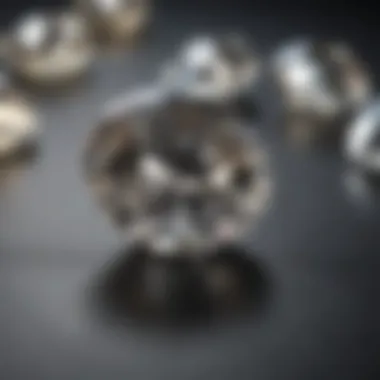

Personal Preferences and Trends
Personal preferences play a crucial role in the selection of diamond cuts. Trends in the jewelry industry shift continuously, and today's popular styles may not hold the same allure tomorrow. As such, buying a diamond that resonates with one’s personal values and preferences is important for long-term satisfaction.
Current trends show an increasing appreciation for unique shapes and cuts, reflecting individual tastes. From the classic elegance of the cushion cut to the contemporary flair of the oval cut, options abound. Being aware of these trends can help buyers align their choices with their desires while still emphasizing sparkle.
Furthermore, factors like lifestyle should be considered when selecting a diamond cut. A couple who values classic styles may opt for traditional cuts that offer maximum brilliance, while those wanting something distinct might explore lesser-known cuts that still provide plenty of light interaction.
The interaction of personal style with current market trends leads to a more fulfilling choice. Ultimately, engaging with different cuts and understanding their implications on sparkle will enable buyers to make informed decisions.
Maximizing sparkle requires a balanced approach that considers both personal taste and technical features of diamond cuts.
Maintaining Diamond Brilliance
Maintaining diamond brilliance is crucial for preserving the aesthetic and monetary value of these precious stones. Proper care ensures that the diamond retains its shine and sparkle over time. Diamonds, although highly durable, can still accumulate dirt and oil from regular wear, diminishing their lustrous appeal. This section highlights the significance of consistent diamond maintenance, focusing on effective cleaning methods and preventive measures to protect against damage.
Cleaning and Care Recommendations
To keep a diamond shining brightly, regular cleaning is paramount. Here are recommended cleaning practices:
- Use mild soap and warm water: Mix a few drops of dish soap in a bowl with warm water. Soaking the diamond for about 15 to 20 minutes loosens built-up grime.
- Soft toothbrush for gentle scrubbing: After soaking, use a soft-bristled toothbrush to gently scrub the diamond and its setting. This step helps remove particles that a mere soak might not eliminate.
- Rinse thoroughly with water: After scrubbing, rinse the diamond under warm running water. Ensure that the drain is covered to avoid accidental loss.
- Pat dry with a lint-free cloth: Gently pat the diamond dry using a lint-free cloth to avoid scratching.
Occasional professional cleaning is also advisable. Jewelers possess special tools and cleaning solutions that can rejuvenate diamond brilliance without risking damage.
Protecting Against Damage
Preventing damage is equally important in the quest to maintain a diamond's brilliance. Here are effective strategies to shield diamonds from harm:
- Avoid exposure to harsh chemicals: Chemicals found in household cleaners, swimming pools, and even some beauty products can dull a diamond’s shine. Remove diamond jewelry before using these substances.
- Store safely: When not being worn, diamonds should be stored in a soft cloth or a dedicated jewelry box. This prevents scratches from contact with other gemstones or metals.
- Limit wear during physical activities: Gems can be more susceptible to damage during strenuous activities. It is generally a wise practice to remove diamond jewelry when engaging in sports or heavy physical work.
"The beauty of a diamond lies as much in its care as in its cut."
For more in-depth information on diamond care, visit Wikipedia.
Current Trends in Diamond Cuts
Current trends in diamond cuts are significant not only for their aesthetic appeal but also for how they enhance the natural brilliance of diamonds. Jewelry buyers are increasingly concerned with how cuts influence sparkle, and these trends reflect both consumer preferences and advancements in technology. The changing tastes affect design choices within the industry, and thus it is essential to keep abreast of what's popular.
Emerging Cuts and Styles
Emerging cuts and styles show a notable shift towards unique shapes and designs. Traditional cuts like the round and princess are still favored, but newer styles are gaining attention. Shapes like the radiant, cushion, and even pear are being reimagined for their distinctive qualities. Additionally, many designers are experimenting with asymmetrical designs that disrupt conventional forms, appealing to those seeking individuality in their jewelry.
The rise of alternative cuts allows for distinct personalization. Consumers are willing to invest in pieces that reflect their style rather than adhering to classic preferences. Other notable trends include mixed-cut diamonds, which combine attributes from several traditional cuts. This technique attempts to maximize light interaction and enhance the visual impact of each stone.
Influence of Technology on Cutting Techniques
Technological advancements have significantly transformed diamond cutting techniques over recent years. Cutting-edge technologies, like laser cutting, enable jewelers to achieve precision that was previously unimaginable. These advances allow for more intricate designs and cuts that maximize the diamond's brilliance.
Also, software simulations have become invaluable tools for designers. They allow for virtual modeling of how light will interact with a diamond based on its cut. This technology helps in developing innovative approaches to customize cuts for the best possible sparkle.
The combination of technology and artistry enables jewelers to push boundaries. Their capability to produce complex and daring designs meets the demands of a discerning audience. Engaging with these developments ensures that jewelers remain relevant in a continuously evolving market.
"Staying updated with current trends in diamond cuts is essential for any professional in the industry, as it enables them to meet customer desires effectively."
As traditions are challenged by new styles, the diamond industry's landscape continues to shift. Those who understand these trends can better inform their purchasing decisions, ensuring they choose pieces that not only shine bright but also resonate with contemporary tastes.
Culmination: The Science of the Shine
The conclusion serves as a pivotal point in understanding the intricate relationship between diamond cuts and their visual appeal. A diamond's sparkle is not merely an attribute; it is a multifaceted result of careful considerations in cutting technique, light interaction, and optical principles. This article has taken a comprehensive approach to dissect various elements influencing diamond brilliance, providing not just technical details but also insights applicable to enthusiasts and professionals alike.
In summary, awareness of how different cuts impact light behavior can significantly enhance one’s selection process. Factors such as the diamond's proportions, angle, and finish all contribute to its overall aesthetic appeal. A deeper comprehension of these elements can lead to more informed purchasing decisions, ensuring greater satisfaction.
Moreover, maintaining a diamond's beauty through appropriate care cannot be underestimated. Understanding cleaning methods and protection strategies contributes to the longevity of a diamond's ideal visual state. These practices are essential for anyone looking to maximize their investment in such a precious stone.
"A diamond's brilliance depends not only on its cut but also on the ongoing relationship between the owner and their care of the stone."
Recap of Key Points
- Importance of Cut: The cut determines how light interacts with the diamond, affecting sparkle and brilliance.
- Types of Diamond Cuts: Various cuts, such as Round, Princess, and Emerald, offer distinct visual experiences. Each cut has unique attributes that cater to different preferences.
- Light Interaction: Refraction, reflection, and dispersion play crucial roles in achieving maximum sparkle.
- Proportions Matter: Key proportions of a diamond directly influence its ability to shine.
- Future Trends: Innovation continues to shape diamond cutting, reflecting advances in technology and changing market preferences.
Future Directions in Diamond Cutting
As the demand for unique and stunning diamond pieces evolves, the future of diamond cutting is bound to change in several ways. Advancements in technology offer new techniques, such as laser cutting, which allow for enhanced precision that traditional methods may not achieve. These innovations can result in more intricate designs that still prioritize the essential aspects of sparkle and brilliance.
Environmental considerations are also becoming a focus, as ethical sourcing and sustainable practices gain prominence in the industry. Consumers increasingly favor diamonds that align with their values, influencing how diamonds are cut and marketed.
Additionally, as gemological knowledge spreads, consumers are becoming more educated about diamond cuts and their significance. This trend will soundly push jewelers to provide greater transparency and information regarding the cuts they offer. With choices becoming more personalized, the relationship between consumers and the diamond will transform, leading to future collaborations.
In summary, the diamond cutting landscape is not static. It is marked by continuous progress in technology, consumer awareness, and ethical practices. As these areas develop, they will undoubtedly reshape what it means to maximize sparkle in diamonds.
